The global FIBC market is valued at USD 6.8 billion in 2025 and is slated to reach USD 12.4 billion by 2035, recording an absolute increase of USD 5.6 billion over the forecast period. This translates into a total growth of 82.4%, with the market forecast to expand at a compound annual growth rate (CAGR) of 6.2% between 2025 and 2035. The overall market size is expected to grow by nearly 1.82X during the same period, supported by increasing demand for cost-effective bulk packaging solutions, growing adoption in chemical and pharmaceutical industries, and rising preference for efficient material handling across construction and mining applications.
Between 2025 and 2030, the FIBC market is projected to expand from USD 6.8 billion to USD 9.1 billion, resulting in a value increase of USD 2.3 billion, which represents 41.1% of the total forecast growth for the decade. This phase of development will be shaped by increasing agricultural commodity exports, rising adoption of specialized anti-static and conductive FIBCs, and growing demand for safe handling solutions in pharmaceutical powder manufacturing. Chemical manufacturers are expanding their FIBC sourcing capabilities to address the growing demand for contamination-free transport, UN-certified hazardous material handling, and efficient warehouse space optimization.
From 2030 to 2035, the market is forecast to grow from USD 9.1 billion to USD 12.4 billion, adding another USD 3.3 billion, which constitutes 58.9% of the overall ten-year expansion. This period is expected to be characterized by the expansion of circular economy initiatives for FIBC recycling, the integration of smart tracking technologies with RFID tags, and the development of hybrid FIBCs with enhanced moisture barrier properties. The growing adoption of automation in material handling and increasing focus on worker safety will drive demand for FIBCs with improved lifting mechanisms and certified load-bearing capabilities.
Manufacturers are developing FIBCs that offer enhanced durability, UV resistance, and moisture protection to meet the growing needs of various industries. Additionally, the increasing focus on environmental sustainability is driving the demand for recyclable and biodegradable FIBCs. With growing awareness of the environmental impact of single-use plastics, FIBC manufacturers are investing in more eco-friendly materials and production techniques, further fueling market growth.
Regionally, Asia-Pacific is the dominant market for FIBCs, driven by large-scale manufacturing and agriculture in countries like China and India. The region also serves as a major production hub for FIBC manufacturers, offering cost advantages in terms of labor and material costs. North America and Europe follow, with robust demand driven by the agricultural, chemical, and construction industries. However, Latin America and the Middle East are expected to show strong growth rates, as both regions experience infrastructure development and increased demand for efficient logistics solutions.
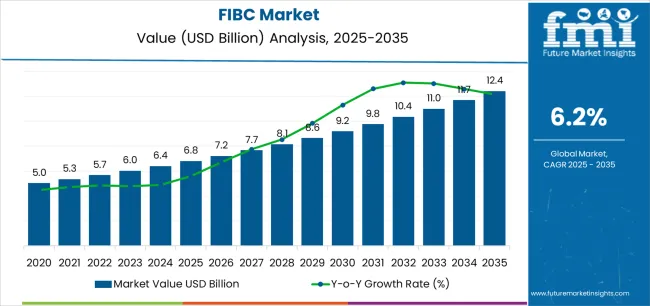
| Metric | Value |
|---|---|
| Estimated Value in (2025E) | USD 6.8 billion |
| Forecast Value in (2035F) | USD 12.4 billion |
| Forecast CAGR (2025 to 2035) | 6.2% |
Market expansion is being supported by the increasing global demand for efficient bulk packaging solutions and the corresponding need for lightweight containers that can reduce transportation costs, improve warehouse space utilization, and provide safe handling capabilities across various industrial applications. Modern chemical manufacturers are increasingly focused on implementing packaging solutions that can support hazardous material transport, enhance product protection during storage, and provide consistent performance in diverse operational environments. FIBCs' proven ability to deliver exceptional strength-to-weight ratios, customizable design features, and compliance with international transport regulations make them essential packaging solutions for contemporary industrial operations and agricultural commodity handling.
The growing emphasis on logistics efficiency and material handling optimization is driving demand for FIBCs that can support faster loading and unloading operations, reduce packaging waste, and enable automated filling systems. Manufacturers' preference for packaging that combines durability with processing efficiency and design flexibility is creating opportunities for innovative FIBC implementations. The rising influence of construction activity expansion and mining operations growth is also contributing to increased demand for FIBCs that can provide reliable containment, easy transport handling, and protection against contamination.
The FIBC market is poised for steady growth and transformation. As industries across food processing, chemicals, construction, pharmaceuticals, and agriculture seek packaging that delivers exceptional efficiency, safety, and handling advantages, FIBCs are gaining prominence not just as commodity packaging but as strategic enablers of logistics optimization and cost reduction.
Rising agricultural exports in Asia-Pacific and expanding construction activity globally amplify demand, while manufacturers are leveraging innovations in fabric coating technologies, specialized liner systems, and certified safety features.
Pathways like specialized anti-static solutions, enhanced barrier properties, and application-specific customization promise strong margin uplift, especially in high-value segments. Geographic expansion and vertical integration will capture volume, particularly where local manufacturing capabilities and supply chain proximity are critical. Regulatory pressures around food safety, chemical transport standards, pharmaceutical handling requirements, and worker safety give structural support.
The market is segmented by product type, capacity, fabric type, filling method, application, and region. By product type, the market is divided into Type A (standard), Type B (anti-static), Type C (conductive), and Type D (static dissipative). By capacity, it covers below 500 kg, 500-1000 kg, 1000-1500 kg, and above 1500 kg. By fabric type, it is segmented into coated fabric and uncoated fabric. The filling method includes top filling, bottom filling, and side filling. By application, the market covers food & agriculture, chemicals & pharmaceuticals, construction & mining, and others. Based on end use loops, the market is categorized into single-trip and multi-trip. By distribution channel, the market includes direct sales, distributors, and online channels. Regionally, the market is divided into North America, Europe, East Asia, South Asia & Pacific, Latin America, and the Middle East & Africa.
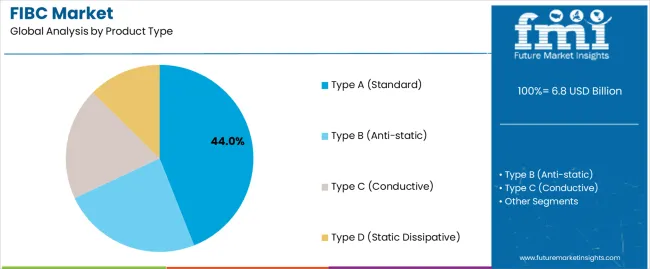
The Type A (standard) FIBCs segment is projected to account for 44.0% of the FIBC market in 2025, reaffirming its position as the leading product category. Agricultural commodity handlers increasingly utilize Type A FIBCs for their cost-effectiveness, reliable performance in non-hazardous material transport, and versatility across applications ranging from grain storage to fertilizer distribution. Type A FIBC technology's straightforward manufacturing process and proven durability directly address the industrial requirements for economical bulk packaging and efficient material handling in high-volume distribution environments.
This product segment forms the foundation of modern agricultural logistics operations, as it represents the FIBC type with the greatest market penetration and established demand across multiple application categories and industry sectors. Manufacturer investments in advanced weaving technologies and quality control systems continue to strengthen adoption among commodity traders. With companies prioritizing load-bearing capacity and storage efficiency, Type A FIBCs align with both operational performance requirements and cost optimization objectives, making them the central component of comprehensive bulk packaging strategies.
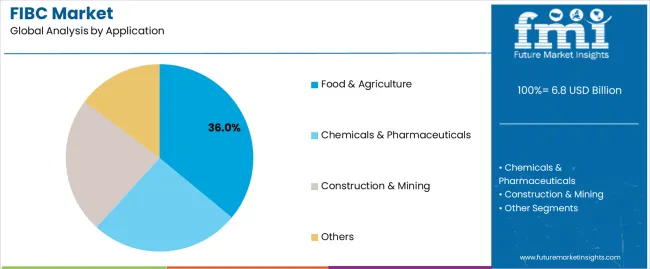
Food & agriculture applications are projected to represent 36.0% of FIBC demand in 2025, underscoring their critical role as the primary industrial consumers of bulk packaging solutions for grain transport, seed distribution, and agricultural commodity handling. Agricultural processors prefer FIBCs for their exceptional loading efficiency, storage space optimization, and ability to maintain product integrity during transport and storage. Positioned as essential packaging for modern agricultural supply chains, FIBCs offer both economic advantages and handling efficiency benefits.
The segment is supported by continuous growth in agricultural exports and the growing availability of food-grade certified FIBCs that enable safe handling of consumable products with validated hygienic manufacturing. Additionally, agricultural cooperatives are investing in standardized FIBC specifications to support large-volume procurement and quality assurance. As global food trade becomes more prevalent and commodity handling requirements increase, food & agriculture applications will continue to dominate the end-use market while supporting efficient material distribution and product safety strategies.
The FIBC market is advancing steadily due to increasing demand for cost-effective bulk packaging and growing adoption of efficient material handling solutions that provide weight reduction, storage optimization, and transport cost savings across diverse industrial applications. However, the market faces challenges, including competition from rigid intermediate bulk containers, concerns about single-use plastic waste, and the need for specialized manufacturing equipment investments. Innovation in fabric coating technologies and safety certification development continues to influence product development and market expansion patterns.
The growing adoption of UN certification requirements, Safe Quality Food (SQF) standards, and industry-specific safety protocols is enabling FIBC manufacturers to produce certified solutions with validated performance characteristics, enhanced safety features, and documented quality assurance. Comprehensive certification programs provide improved market access while allowing more efficient entry into regulated industries and consistent compliance across various application requirements and geographic markets. Manufacturers are increasingly recognizing the competitive advantages of certified capabilities for product differentiation and premium market positioning.
Modern FIBC suppliers are incorporating RFID tags, barcode integration, and digital tracking systems to enhance inventory management, enable real-time location monitoring, and deliver value-added supply chain solutions to end users. These technologies improve operational efficiency while enabling new service models, including returnable FIBC programs, automated inventory replenishment, and predictive maintenance scheduling. Advanced tracking integration also allows manufacturers to support premium service positioning and operational transparency beyond traditional bulk packaging supply.
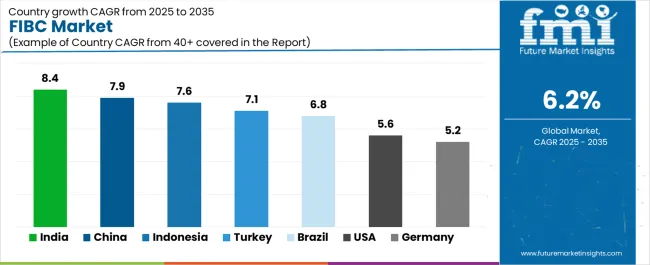
| Country | CAGR (2025-2035) |
|---|---|
| India | 8.4% |
| China | 7.9% |
| USA | 5.6% |
| Germany | 5.2% |
| Brazil | 6.8% |
| Turkey | 7.1% |
| Indonesia | 7.6% |
The FIBC market is experiencing solid growth globally, with India leading at an 8.4% CAGR through 2035, driven by the expanding agricultural export sector, growing chemical manufacturing base, and significant investment in construction infrastructure development. China follows at 7.9%, supported by robust chemical production growth, increasing mining operations, and growing domestic commodity handling requirements. The USA shows growth at 5.6%, emphasizing food safety standards and specialty chemical packaging. Brazil records 6.8%, focusing on agricultural commodity exports and fertilizer distribution. Germany demonstrates 5.2% growth, prioritizing chemical industry applications and quality manufacturing standards. Turkey exhibits 7.1% growth, emphasizing construction material handling and agricultural processing. Indonesia shows 7.6% growth, supported by palm oil industry demand and construction sector expansion.
The report covers an in-depth analysis of 40+ countries top-performing countries are highlighted below.
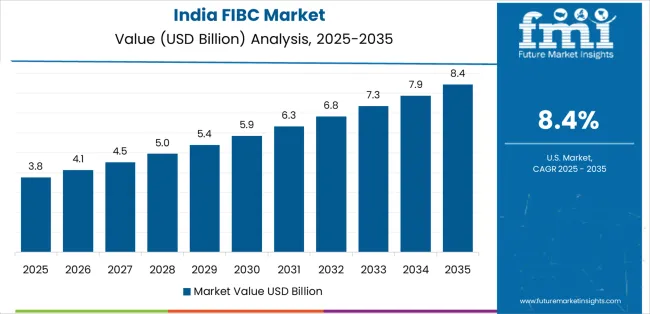
Revenue from FIBCs in India is projected to exhibit exceptional growth with a CAGR of 8.4% through 2035, driven by expanding agricultural commodity exports and rapidly growing chemical manufacturing supported by government initiatives promoting domestic production capacity development. The country's dominant position in rice, wheat, and sugar exports and increasing investment in fertilizer manufacturing are creating substantial demand for efficient bulk packaging solutions. Major agricultural cooperatives and chemical manufacturers are establishing comprehensive FIBC sourcing capabilities to serve both domestic distribution and international export requirements.
Revenue from FIBCs in China is expanding at a CAGR of 7.9%, supported by the country's extensive chemical production capacity, expanding mining operations, and increasing adoption of mechanized material handling solutions. The country's massive construction activity and growing demand for efficient logistics solutions are driving requirements for sophisticated FIBC capabilities. International suppliers and domestic manufacturers are establishing extensive production and distribution capabilities to address the growing demand for bulk packaging products.
Revenue from FIBCs in the USA is expanding at a CAGR of 5.6%, supported by the country's stringent food safety requirements, strong emphasis on quality certification, and robust demand for specialized packaging in pharmaceutical and chemical applications. The nation's mature agricultural sector and high-value specialty chemical focus are driving sophisticated FIBC capabilities throughout the supply chain. Leading manufacturers and packaging distributors are investing extensively in certified production capabilities and traceability systems to serve both domestic and export markets.
Revenue from FIBCs in Brazil is growing at a CAGR of 6.8%, driven by the country's leadership in agricultural commodity exports, expanding sugar and coffee production, and growing investment in fertilizer distribution infrastructure. Brazil's position as a major soybean and corn exporter and commitment to agricultural modernization are supporting demand for efficient bulk packaging solutions across multiple commodity segments. Manufacturers are establishing comprehensive distribution capabilities to serve the vast agricultural interior regions and port facilities.
Revenue from FIBCs in Germany is expanding at a CAGR of 5.2%, supported by the country's chemical industry leadership, advanced manufacturing capabilities, and strategic focus on high-quality certified packaging solutions. Germany's engineering excellence and regulatory compliance emphasis are driving demand for FIBCs in pharmaceutical ingredients, specialty chemicals, and industrial powder applications. Manufacturers are investing in comprehensive testing capabilities to serve both domestic chemical producers and international pharmaceutical markets.
Revenue from FIBCs in Turkey is growing at a CAGR of 7.1%, driven by the country's robust construction activity, expanding mining operations, and strategic position bridging European and Asian markets. Turkey's cement production capacity and aggregate processing infrastructure are supporting investment in efficient bulk packaging throughout major construction material supply chains. Industry participants are establishing comprehensive manufacturing capabilities to serve domestic demand and regional export opportunities.
Revenue from FIBCs in Indonesia is expanding at a CAGR of 7.6%, supported by the country's palm oil industry dominance, growing construction sector, and expanding chemical manufacturing base. Indonesia's position as the world's largest palm oil producer and integrated agricultural processing capabilities are driving demand for specialized FIBCs in agricultural commodity handling and oleochemical transport applications. Leading manufacturers are investing in localized production capabilities to serve the stringent requirements of food processing and chemical industries.
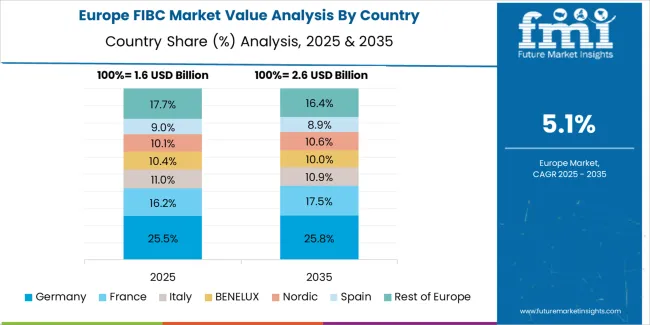
The FIBC market in Europe is projected to grow from USD 1.4 billion in 2025 to USD 2.6 billion by 2035, registering a CAGR of 6.4% over the forecast period. Germany is expected to maintain its leadership position with a 28.0% market share in 2025, declining slightly to 27.5% by 2035, supported by its strong chemical industry, advanced manufacturing capabilities, and comprehensive industrial base serving diverse FIBC applications across Europe.
France follows with a 18.0% share in 2025, projected to reach 18.5% by 2035, driven by robust demand for FIBCs in agricultural commodity handling, chemical manufacturing, and pharmaceutical ingredient packaging, combined with established food safety standards and specialty packaging expertise. The United Kingdom holds a 15.0% share in 2025, expected to maintain 15.0% through 2035, supported by strong pharmaceutical manufacturing and growing construction materials distribution. Italy commands a 13.0% share in 2025, projected to reach 13.5% by 2035, while Spain accounts for 9.0% in 2025, expected to reach 9.5% by 2035. The Netherlands maintains a 5.5% share in 2025, growing to 6.0% by 2035. The Rest of Europe region, including Nordic countries, Eastern Europe, Belgium, Switzerland, Austria, and Poland, is anticipated to gain momentum, expanding its collective share from 11.5% to 10.0% by 2035, attributed to increasing construction activity in Eastern Europe and growing chemical manufacturing in Poland implementing efficient bulk packaging programs.
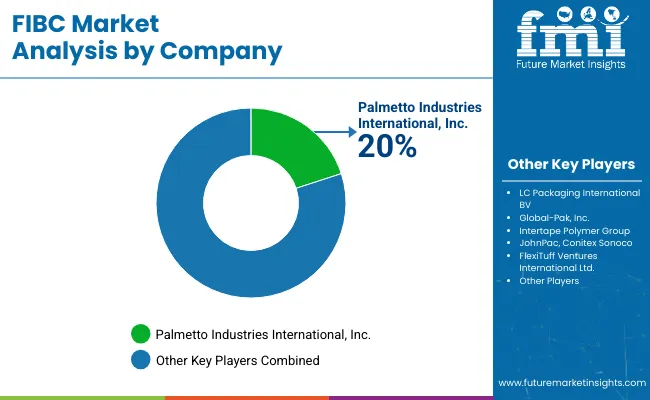
The FIBC market features 10–15 players with moderate concentration, where the top three companies collectively hold around 45–52% of global market share. Growth is driven by rising demand from bulk material handling across industries such as agriculture, construction, chemicals, and food processing. The leading company, Berry Global Inc., commands 12% market share, supported by its extensive FIBC product portfolio, strong global manufacturing capabilities, and long-term relationships with key customers in the food and chemical sectors. Competition centers on load-bearing capacity, durability, customization, and compliance with safety standards rather than price alone.
Market leaders such as Berry Global Inc., Greif, Inc., and BAG Corp maintain dominant positions by offering high-quality, customizable FIBCs designed for safe, cost-effective, and efficient bulk material transport. Their strengths lie in advanced fabric technology, multi-layer construction, and the ability to meet regulatory requirements for hazardous materials and food-grade packaging.
Challenger companies including LC Packaging International BV, Emmbi Industries Limited, and Conitex Sonoco compete through specialized FIBCs for niche markets, such as agrochemical packaging, waste disposal, and high-volume industrial applications, emphasizing product strength, recyclability, and customer-specific solutions.
Additional competition comes from Bulk Lift International, Taihua Group, Halsted Corporation, and MiniBulk Inc., which enhance their market presence through cost-effective solutions, regional supply chains, and tailored FIBC designs for specific bulk handling needs.
| Items | Values |
|---|---|
| Quantitative Units (2025) | USD 6.8 billion |
| Product Type | Type A (Standard), Type B (Anti-static), Type C (Conductive), Type D (Static Dissipative) |
| Capacity | Below 500 kg, 500-1000 kg, 1000-1500 kg, Above 1500 kg |
| Fabric Type | Coated Fabric, Uncoated Fabric |
| Filling Method | Top Filling, Bottom Filling, Side Filling |
| Application | Food & Agriculture, Chemicals & Pharmaceuticals, Construction & Mining, Others |
| End Use Loops | Single-trip, Multi-trip |
| Distribution Channel | Direct Sales, Distributors, Online Channels |
| Regions Covered | North America, Europe, East Asia, South Asia & Pacific, Latin America, Middle East & Africa |
| Countries Covered | United States, Canada, United Kingdom, Germany, France, China, Japan, South Korea, India, Brazil, Turkey, Indonesia and 40+ countries |
| Key Companies Profiled | Berry Global Inc., Greif, Inc., BAG Corp, LC Packaging International BV, Emmbi Industries Limited, Conitex Sonoco, Bulk Lift International, Taihua Group, Halsted Corporation, and MiniBulk Inc. |
| Additional Attributes | Dollar sales by product type and application category, regional demand trends, competitive landscape, technological advancements in fabric coating systems, safety certification development, liner integration innovation, and supply chain optimization |
The global fibc market is estimated to be valued at USD 6.8 billion in 2025.
The market size for the fibc market is projected to reach USD 12.4 billion by 2035.
The fibc market is expected to grow at a 6.2% CAGR between 2025 and 2035.
The key product types in fibc market are type a (standard), type b (anti-static), type c (conductive) and type d (static dissipative).
In terms of application, food & agriculture segment to command 36.0% share in the fibc market in 2025.






Our Research Products

The "Full Research Suite" delivers actionable market intel, deep dives on markets or technologies, so clients act faster, cut risk, and unlock growth.

The Leaderboard benchmarks and ranks top vendors, classifying them as Established Leaders, Leading Challengers, or Disruptors & Challengers.

Locates where complements amplify value and substitutes erode it, forecasting net impact by horizon

We deliver granular, decision-grade intel: market sizing, 5-year forecasts, pricing, adoption, usage, revenue, and operational KPIs—plus competitor tracking, regulation, and value chains—across 60 countries broadly.

Spot the shifts before they hit your P&L. We track inflection points, adoption curves, pricing moves, and ecosystem plays to show where demand is heading, why it is changing, and what to do next across high-growth markets and disruptive tech

Real-time reads of user behavior. We track shifting priorities, perceptions of today’s and next-gen services, and provider experience, then pace how fast tech moves from trial to adoption, blending buyer, consumer, and channel inputs with social signals (#WhySwitch, #UX).

Partner with our analyst team to build a custom report designed around your business priorities. From analysing market trends to assessing competitors or crafting bespoke datasets, we tailor insights to your needs.
Supplier Intelligence
Discovery & Profiling
Capacity & Footprint
Performance & Risk
Compliance & Governance
Commercial Readiness
Who Supplies Whom
Scorecards & Shortlists
Playbooks & Docs
Category Intelligence
Definition & Scope
Demand & Use Cases
Cost Drivers
Market Structure
Supply Chain Map
Trade & Policy
Operating Norms
Deliverables
Buyer Intelligence
Account Basics
Spend & Scope
Procurement Model
Vendor Requirements
Terms & Policies
Entry Strategy
Pain Points & Triggers
Outputs
Pricing Analysis
Benchmarks
Trends
Should-Cost
Indexation
Landed Cost
Commercial Terms
Deliverables
Brand Analysis
Positioning & Value Prop
Share & Presence
Customer Evidence
Go-to-Market
Digital & Reputation
Compliance & Trust
KPIs & Gaps
Outputs
Full Research Suite comprises of:
Market outlook & trends analysis
Interviews & case studies
Strategic recommendations
Vendor profiles & capabilities analysis
5-year forecasts
8 regions and 60+ country-level data splits
Market segment data splits
12 months of continuous data updates
DELIVERED AS:
PDF EXCEL ONLINE
FIBC Industry Analysis in Japan Size and Share Forecast Outlook 2025 to 2035
Market Share Distribution Among FIBC (Flexible Intermediate Bulk Container) Manufacturers
2 Loop FIBC Bags Market Size and Share Forecast Outlook 2025 to 2035
4-Loop FIBC Market Growth - Size, Demand & Forecast 2025 to 2035
Breaking Down Market Share in 2 Loop FIBC Bags
Competitive Landscape of 4-Loop FIBC Providers
Ventilated FIBC Market Size, Share & Forecast 2025 to 2035

Thank you!
You will receive an email from our Business Development Manager. Please be sure to check your SPAM/JUNK folder too.
Chat With
MaRIA